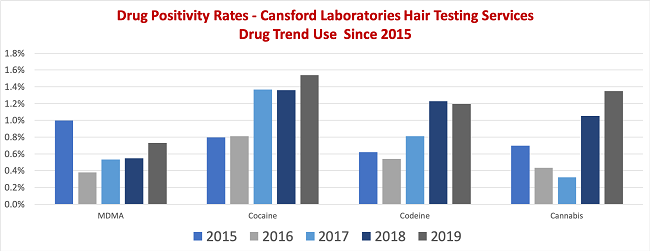CANSFORD LABS
UK Workplace drug testing: the most common substances found during tests
on Aug 28, 2019
We regularly bang the drum for increased workplace drug testing: guidelines for the process, questions to ask your testing partner, how to make sure you get your workplace testing programme right.
And for good reason. Workplace drug and alcohol misuse - particularly in safety-sensitive industries - can have serious consequences, potentially endangering not only the life of the employee in question, but the lives of their co-workers and quite possibly the company’s customers, too.
Studies have shown that the presence of a workplace drug testing programme can deter worker drug use – another good reason to have a testing programme and policy in place. At Cansford, the number of workplace drug and alcohol tests we carry out each year continues to grow. This give us plenty of data so we can uncover trends and establish which drugs are proving to be the biggest cause for concern, and which are becoming less common.
So, let’s delve into that data to find out how workplace drug and alcohol use has changed since 2015...
British workers’ drugs of choice

Since 2015, according to our own internal positivity rate data, we’ve seen a continued rise in the use of three substances in particular – cocaine, ecstasy (MDMA) and cannabis. For these three substances (plus codeine), the workplace positivity rate sits at around 1-2%.
According to data from the 2017/18 Crime Survey for England and Wales, powder cocaine usage amongst the general population is on the rise. And it’s no longer solely city workers and rock stars that are fuelling the trend. The drug’s purity has increased and its price has come down, which could explain why more people are giving it a go. Add in aggressive marketing by cocaine dealers, and it’s clear to see how a new target market can become addicted.
...that’s not the case for cannabis or ecstasy
However, while our data tallies with government statistics for cocaine, that’s not the case for cannabis or ecstasy. Crime Survey statistics show that cannabis use in England and Wales has dropped significantly since 1996, while the number of people using ecstasy has remained fairly stable over the years.
Other stats
While cannabis use may be down at an overall level, this isn’t the case for every subset of the population. In mid-2018, researchers at the University of York found that the number of over 40s presenting to specialist drug treatment centres citing cannabis as their primary addiction has risen by 118% in the last ten years.
And with the legalisation of the substance in parts of the US and Canada, The Spectator speculates that the drug’s new reputation as a medicinal treatment may be fuelling its use in workers.
About Ecstasy
Usage levels have remained pretty flat over recent years (despite the number of ecstasy-related deaths increasing), so why are we detecting higher usage in the setting of the workplace? It could be partly down to a perceived increase in social acceptability of ecstasy use (‘E’s n Cheese’ parties apparently being one of the latest trends), but it could also be a result of ecstasy’s changing nature.
People actually prefer taking new ‘research chemical’ drugs
While purity has increased amongst some sellers, others sell adulterated versions of the drug. The Independent reports that “a lot of people actually prefer taking new ‘research chemical’ drugs as opposed to real ecstasy because they remain ‘legal’ for a brief period and use generally does not result in arrest.
Others use new drugs intentionally as a means to pass drug tests at work, or even to avoid the stigma of being “a drug user”. And with MDMA being touted as a potential treatment for PTSD, could its popularity grow still further - particularly in safety-sensitive industries where the risk of incidents leading to PTSD is higher?
Stable, but still a problem
Our overall data shows that other substances - amphetamines, diazepam, tramadol, codeine, morphine, methadone and alcohol - have seen no significant increases in positivity rate since 2015.
However, that’s not to say that company leaders shouldn’t be worried about these substances. We’ve written before about how prescriptions for addictive drugs are on the rise, and how Xanax in particular is a real cause for concern in the workplace. In the world of aviation, we’ve shared how pilots have passed out in plane cockpits, with alcohol testing revealing them to be three times over the legal alcohol limit.
In fact, alcohol, morphine, methadone, tramadol, codeine and antidepressants make up six of the top ten most lethal substances in the UK in terms of deaths caused by substance misuse, and can’t be ignored.
What all this means for workplaces
For workplaces, it’s vital that any misuse of substances like those mentioned above is detected as quickly as possible. While these substances may not be used within the workplace itself, their effects may last several days, affecting an individual’s ability to perform their role to their full ability. With productivity, absenteeism, company reputation and health and safety all at stake, measures should be taken to make drug-free workplaces a reality.
It’s vital to get your workplace drug and alcohol testing programme right, right from the outset. Find out how here.

Lolita Tsanaclis
Dr. Lolita Tsanaclis, Chief Scientific Officer of Cansford Laboratories Limited, has been developing methods for the analysis of drugs in hair since 1993. She has been involved in drug testing using hair, blood and oral fluid samples for medico-legal and workplace sectors for over three decades. Dr Tsanaclis is published extensively as author and as co-author in highly regarded peer-reviewed publications and scientific presentations.

